#Leading India News Source
Explore tagged Tumblr posts
Text
'First time I've lost to Arshad Nadeem': Neeraj Chopra 'won't be at peace' unless he eclipses Paris Olympics silver
Neeraj Chopra, India's golden boy in athletics, has once again set his sights on the highest accolades after a rare defeat to his Pakistani rival, Arshad Nadeem. The recent setback has only fueled Chopra's determination to achieve greater success, especially as he looks towards the Paris Olympics.
Chopra has built a reputation as one of the most consistent and dominant javelin throwers on the global stage. However, his recent defeat to Nadeem has stirred something within him. "This is the first time I've lost to Arshad Nadeem," Chopra candidly remarked, highlighting the significance of the loss. The defeat has left Chopra unsatisfied, and he's made it clear that he will not be at peace until he surpasses this performance, particularly with the Paris Olympics on the horizon.
The rivalry between Chopra and Nadeem has been brewing for years, with both the athletes pushing each other to new heights. While Chopra has often had the upper hand, Nadeem's recent victory marks a turning point in their competitive relationship. This defeat, however, has only intensified the Chopra's resolve. He views it as a stepping stone, a momentary setback that will propel him to train harder, refine his technique, and ultimately, reclaim his dominance in the sport.
Chopra's focus is now firmly set on the Paris Olympics, where he aims not just to win but to eclipse his previous achievements. The silver medal at the Tokyo Olympics was a significant milestone, but Chopra believes he can do better. He has his eyes on the gold, and he’s determined to leave no stone unturned in his preparation.
As one of India's most celebrated athletes, Chopra carries the hopes and dreams of millions. His journey is not just about personal glory but also about inspiring the next generation of athletes in India. The defeat to Nadeem, while disappointing, is a reminder that even the best athletes face challenges. What sets Chopra apart is his unwavering commitment to overcoming these challenges and emerging stronger.
In the coming months, as Chopra gears up for the Paris Olympics, fans and critics alike will be watching closely. One thing is certain: Neeraj Chopra won’t rest until he has eclipsed his previous achievements and once again stood at the pinnacle of his sport. For more sports news, subscribe to our newsletter.
#werindia#leading india news source#top news stories#top news headlines#national news#top news of the day#latest national news#sports news today#neeraj chopra#olympic games
2 notes
·
View notes
Text
Scientists have developed a new solar-powered system to convert saltwater into fresh drinking water which they say could help reduce dangerous the risk of waterborne diseases like cholera.
Via tests in rural communities, they showed that the process is more than 20% cheaper than traditional methods and can be deployed in rural locations around the globe.
Building on existing processes that convert saline groundwater to freshwater, the researchers from King’s College London, in collaboration with MIT and the Helmholtz Institute for Renewable Energy Systems, created a new system that produced consistent levels of water using solar power, and reported it in a paper published recently in Nature Water.
It works through a process called electrodialysis which separates the salt using a set of specialized membranes that channel salt ions into a stream of brine, leaving the water fresh and drinkable. By flexibly adjusting the voltage and the rate at which salt water flowed through the system, the researchers developed a system that adjusts to variable sunshine while not compromising on the amount of fresh drinking water produced.
Using data first gathered in the village of Chelleru near Hyderabad in India, and then recreating these conditions of the village in New Mexico, the team successfully converted up to 10 cubic meters, or several bathtubs worth of fresh drinking water. This was enough for 3,000 people a day with the process continuing to run regardless of variable solar power caused by cloud coverage and rain.
[Note: Not sure what metric they're using to calculate daily water needs here. Presumably this is drinking water only.]
Dr. Wei He from the Department of Engineering at King’s College London believes the new technology could bring massive benefits to rural communities, not only increasing the supply of drinking water but also bringing health benefits.
“By offering a cheap, eco-friendly alternative that can be operated off the grid, our technology enables communities to tap into alternative water sources (such as deep aquifers or saline water) to address water scarcity and contamination in traditional water supplies,” said He.
“This technology can expand water sources available to communities beyond traditional ones and by providing water from uncontaminated saline sources, may help combat water scarcity or unexpected emergencies when conventional water supplies are disrupted, for example like the recent cholera outbreaks in Zambia.”
In the global rural population, 1.6 billion people face water scarcity, many of whom are reliant on stressed reserves of groundwater lying beneath the Earth’s surface.
However, worldwide 56% of groundwater is saline and unsuitable for consumption. This issue is particularly prevalent in India, where 60% of the land harbors undrinkable saline water. Consequently, there is a pressing need for efficient desalination methods to create fresh drinking water cheaply, and at scale.
Traditional desalination technology has relied either on costly batteries in off-grid systems or a grid system to supply the energy necessary to remove salt from the water. In developing countries’ rural areas, however, grid infrastructure can be unreliable and is largely reliant on fossil fuels...
“By removing the need for a grid system entirely and cutting reliance on battery tech by 92%, our system can provide reliable access to safe drinking water, entirely emission-free, onsite, and at a discount of roughly 22% to the people who need it compared to traditional methods,” He said.
The system also has the potential to be used outside of developing areas, particularly in agriculture where climate change is leading to unstable reserves of fresh water for irrigation.
The team plans to scale up the availability of the technology across India through collaboration with local partners. Beyond this, a team from MIT also plans to create a start-up to commercialize and fund the technology.
“While the US and UK have more stable, diversified grids than most countries, they still rely on fossil fuels. By removing fossil fuels from the equation for energy-hungry sectors like agriculture, we can help accelerate the transition to Net Zero,” He said.
-via Good News Network, April 2, 2024
#water#water scarcity#clean water#saline#desalination#off grid#battery technology#solar power#solar energy#fossil fuels#water shortage#india#hyderabad#new mexico#united states#uk#united kingdom#good news#hope#aquifers
1K notes
·
View notes
Text
Activists and scientists have been warning for years that schemes to offset carbon emissions by planting trees or other crops would lead to a surge in land grabbing, especially in the global South. These warnings are now proving true. GRAIN combed through the various registries of carbon offset projects to try and get a better sense of this new land grab and how it is unfolding. We identified 279 large-scale tree and crop planting projects for carbon credits that corporations have initiated since 2016 in the global South. They cover over 9.1 million hectares of land -- an area roughly the size of Portugal. The deals add up to a massive new form of land grabbing that will only increase conflicts and pressures over land that are still simmering from the last global land grab spree that erupted in 2007-8 in the wake of global food and financial crises. They also signify that new sources of money are now flowing into the coffers of companies specialised in taking lands from communities in the South to enrich and serve corporations, mainly in the North. To date, 52 countries in the global South have been targeted by these projects. Half the projects are in just four countries: China, India, Brazil and Colombia, which are developing their own industries of carbon project developers. But projects in these countries account for less than a third of the total land area involved. The most affected region, in terms of land area, is Africa, with projects covering over 5.2 million hectares. Many of the projects involve land deals to set up giant eucalyptus, acacia or bamboo plantations. Typically, these are pasture lands or savannahs that were used until now by local communities for grazing livestock or growing food.
17 September 2024
95 notes
·
View notes
Text
Writing Notes: Ethnocentrism & Cultural Relativism

ETHNOCENTRISM
The tendency to look at the world primarily from the perspective of one’s own culture.
Part of ethnocentrism is the belief that one’s own race, ethnic or cultural group is the most important or that some or all aspects of its culture are superior to those of other groups. Some people will simply call it cultural ignorance.
Often leads to incorrect assumptions about others’ behavior based on your own norms, values, and beliefs.
Example: In extreme cases, a group of individuals may see another culture as wrong or immoral and because of this may try to convert, sometimes forcibly, the group to their own ways of living.
War and genocide could be the devastating result if a group is unwilling to change their ways of living or cultural practices.
Ethnocentrism may not, in some circumstances, be avoidable.
We often have involuntary reactions toward another person or culture’s practices or beliefs but these reactions do not have to result in horrible events such as genocide or war.
In order to avoid conflict over culture practices and beliefs, we must all try to be more culturally relative.
CULTURAL RELATIVISM
The principle of regarding and valuing the practices of a culture from the point of view of that culture and to avoid making hasty judgments.
Cultural relativism tries to counter ethnocentrism by promoting the understanding of cultural practices that are unfamiliar to other cultures such as eating insects, genocides or genital cutting.
Example: Consider the common practice of same-sex friends in India walking in public while holding hands. This is a common behavior and a sign of connectedness between two people. In England, by contrast, holding hands is largely limited to romantically involved couples, and often suggests a sexual relationship. These are simply two different ways of understanding the meaning of holding hands.
Someone who does not take a relativistic view might be tempted to see their own understanding of this behavior as superior and, perhaps, the foreign practice as being immoral.
CULTURAL RELATIVISM: Problems
Despite the fact that cultural relativism promotes the appreciation for cultural differences, it can also be problematic.
At its most extreme, cultural relativism leaves no room for criticism of other cultures, even if certain cultural practices are horrific or harmful.
Many practices have drawn criticism over the years.
Example 1: In Madagascar, the famahidana funeral tradition includes bringing bodies out from tombs once every seven years, wrapping them in cloth, and dancing with them. Some people view this practice disrespectful to the body of the deceased person.
Example 2: Today, a debate rages about the ritual cutting of genitals of girls in several Middle Eastern and African cultures. To a lesser extent, this same debate arises around the circumcision of baby boys in Western hospitals.
When considering harmful cultural traditions, it can be patronizing to use cultural relativism as an excuse for avoiding debate.
To assume that people from other cultures are neither mature enough nor responsible enough to consider criticism from the outside is demeaning.
CROSS-CULTURAL RELATIONSHIP
The idea that people from different cultures can have relationships that acknowledge, respect and begin to understand each other’s diverse lives.
People with different backgrounds can help each other see possibilities that they never thought were there because of limitations, or cultural proscriptions, posed by their own traditions.
Becoming aware of these new possibilities will ultimately change the people who are exposed to the new ideas.
This cross-cultural relationship provides hope that new opportunities will be discovered, but at the same time it is threatening. The threat is that once the relationship occurs, one can no longer claim that any single culture is the absolute truth.
Source ⚜ Writing Notes & References
#writing notes#culture#psychology#writeblr#dark academia#writing reference#spilled ink#studyblr#light academia#literature#writers on tumblr#writing prompt#poetry#poets on tumblr#writing inspo#writing ideas#writing inspiration#creative writing#writing resources
110 notes
·
View notes
Text
Dandelion News - December 1-7
Like these weekly compilations? Tip me at $kaybarr1735 or check out my Dandelion Doodles for 50% off this month!
1. These high-tech windows fight climate change – and will save you money

“[“Vacuum-insulated glass”] insulates five times better than double-paned glass. The Enthermal product line holds energy about as well as fiberglass wall insulation[…. T]he energy bill savings offset the upfront cost of the upgrade in two to seven years, depending on the building[….]”
2. Doulas test ways to curb Memphis’ Black maternal, infant deaths

“Research shows they are key to better health outcomes. […] Free of charge, [parents enrolled in this pilot program], in addition to being paired with a doula, get access to free yoga classes, diapers, breastfeeding starter kits, nutritious food and other tangible help that can measurably boost well-being.”
3. Scientists find feeding grazing cattle seaweed cuts methane emissions by almost 40%

“This is the first study to test seaweed on grazing beef cattle in the world. […] Most research to reduce methane emissions using feed additives has taken place in controlled environments with daily supplements. But Kebreab noted in the study that fewer than half of those methods are effective for grazing cattle.”
4. Success for local residents as Florida council toppled over sewage plant plan
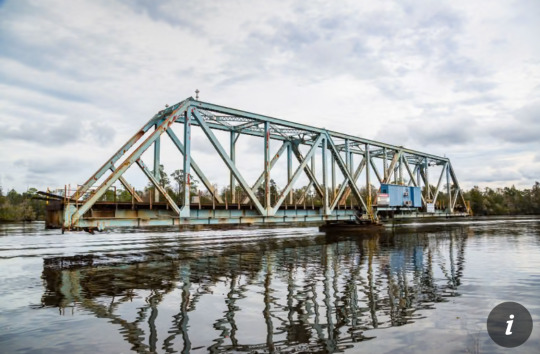
“A citizens’ revolt in a small Florida city ousted an entire slate of councilors who were pushing for a new sewage plant to be built close to one of the state’s most pristine and treasured rivers.”
5. Beaver survey aims to show the urban benefits of Chicago's 'ecosystem engineers'

“Urban Rivers is installing [“artificial floating gardens”] along the river to restore native wetland habitats, which provide food and shelter for wildlife, as well as natural spaces for humans.”
6. The future of plastic: Biodegradable, durable, and even edible

“[… T]he composite plastic proved not only sturdy but also more malleable than its core component, hydroxyethyl cellulose. Additionally, since both cellulose and tyrosine are edible, the biodegradable composite plastic can technically be consumed.”
7. Limestone quarries could be vital for wild bee conservation

“Quarries provide valuable habitats for wild bees and other animals and plants that occur on the now rare calcareous grasslands," explains lead author Dr. Felix Kirsch[….]”
8. New England wedding vendors offer help to same-sex couples before Trump inauguration

“Marriage equality isn’t immediately at risk. Trump has said he considers it settled law, but of course it’s hard to take him at his word […] so vendors in the region are offering free or discounted services to queer couples and noncitizens in a rush to marry.”
9. The indigenous women saving India's endangered giant yams

“Since their formation in 2022, the 10 members of the Noorang group have planted and brought back to the community 180 varieties of wild tubers[….] The project is part of [… a] farming initiative to eradicate poverty, provide agricultural training and empower women in vulnerable tribal communities.”
10. The US is making and deploying more solar panels than ever before

“[… D]omestic solar module manufacturing capacity has nearly quintupled since 2022[….] Solar is the cheapest source of new power generation by far, and it’s an increasingly large employer in the U.S., particularly in Republican-led states.”
November 22-28 news here | (all credit for images and written material can be found at the source linked; I don’t claim credit for anything but curating.)
#hopepunk#good news#solar panels#solar energy#solar power#climate change#co2 emissions#cattle#seaweed#india#yams#food insecurity#beaver#habitat#conservation#bees#florida#civic engagement#new england#same sex marriage#gay marriage#marriage#us politics#plastic#science#home improvement#thermal insulation#parenting#perinatal#medicine
68 notes
·
View notes
Text
Direct electrification and talking trains
(another nearly 5k word post)
A lot of people will make Electra mostly battery-operated (including the revival), but canon, through the lyrics of AC/DC and Electra’s replica design and “pantograph pose” pretty explicitly make them a non-battery electric engine that runs off overhead power. Which imo is a very interesting and underexplored topic that affects a lot of dynamics. Electrification has fascinating potential for a lot of social themes that aren’t seriously explored in Anglophone media, it’s a “fourth dimension” that impacts so much but is treated as a non-entity.



It’s actually kind of… sad how train media seems to be quietly “batterywashing” electric trains that would be powered by overhead wire or third rail and really overselling a flawed technology while ignoring a proven, almost uniquely “train” power source with a fascinating history and practicalities. Early tech limits have a massive effect on even modern trains in the US and Europe, and countries’ adoption or rejection of electrification tends to say a lot about their political and economic outlook. It’s something that’s a no-brainer when rail is a public service focused on the long term, and usually a nonstarter when it’s a private business focused on short term returns.
So I’m going to cover some of the basics of it and my own takes on how it could affect a talking train society.
This topic is totally alien to a lot of people, so I’ll try and keep this as non-technical as possible. While this post focuses on Electra, a lot of these things would also apply to the Nationals or electric OCs. And while this is mostly aimed at the Starlight Express physical setup and themes, a lot of this info could be applied to more realistic Thomas-style talking trains.
(Note: I use “direct electric” because I’m not even sure there’s a specific term for non-battery electric trains besides just plain “electric”. I’ve seen “straight electric” which is hilariously ironic with Electra specifically. I avoid “pure electric” because it’s often weaponized to make the character a Malfoy-esque figure, which annoys me to all hell because it couldn’t be further from the truth. Electric trains have a notoriously liberal and diverse fanbase and it feels downright slanderous to make them out to be rich supremacists. Those types HATE actual electric trains.)
On the most basic level, direct electric-only Electra (and most of the Nationals) would be like a whale. Whales are almost unstoppably dominant outside of human threats… unless they end up out of the water, where they’re pretty much immobile and helpless. Outside of areas with compatible overhead power (or perhaps third rail), or if their pantograph or other current collector was damaged, they would also be pretty much immobile and helpless. Usually electric engines like that have a small battery (akin to a combustion car’s) that can power lights and controls when disconnected, but that’s about it. So they might be able to respond to basic commands, answer yes/no, but not move without outside assistance.


Which leads to the VERY interesting situation where they would be bricked in 99% of the US, most secondary and smaller lines in the UK, and even a number of branch lines in Europe. There’s major limits on where they can go, and even where they can go, the infrastructure they need is vulnerable to neglect and underinvestment. It parallels disability accessibility in a lot of ways. With the fascinating caveat that some countries like Switzerland and India are 100% electrified and with that accommodation omnipresent, being electric-only isn’t even “a disability” anymore, it’s just the norm. Directly electrified trains actually dominate nearly all metrics of speed, strength, and power and are a nearly perfect metaphor for someone or something that excels in pure meritocracy but is repeatedly held back by institutional forces and government underfunding, and tends to be the first affected when programs are axed. Half my fascination with the show and character is just how much better Electra fits the social themes they tried to implement early on, and how there could have been a story “just about trains” that also strongly mirrors human politics. The broader problems of utilities being public services vs private businesses, and underfunded services being deliberately sabotaged by conservative governments to axe or privatize them have only become more relevant since the 80s in so many non-train avenues.
(Electric trains in the Anglosphere are a Rorschach test of minority coding in general, with even more parallels in how they’re viewed as faceless statistics, their history has often been overlooked, forgotten, and outright erased, and are portrayed as an alien threat when they’ve been around for a century+ and have quietly done a lot of grunt work without much fanfare.)
A VERY different and more fanciful take is found in the “Electricity Fairy” of early 20th century France. This is a fantastic article about it in regard to model trains and French electrification, by an author who is incredible at characterizing electric trains in general (machine translation dampens things a little but his main points come across well). Electricity as a sort of Tinkerbell figure to a Peter Pan-esque Electra is a very compelling direction, especially with the thematic and personality parallels between the two characters.


EMUS AND LOCOMOTIVES
Before I go on, I need to address this distinction. EMUs are self propelled electric railcars, basically coaches with motors attached. Like a subway train. Locomotives pull unpowered cars. This is why I keep saying the vaguer term “train” vs “engine” because most of this post is relevant to both setups. Diesel-powered multi units also exist… and bimode and battery and all three at once. The MU/locomotive divide exists for those too, it’s just more prominent in electric systems since the advantages of electric traction are utilized so differently by locomotives vs MUs. MUs are almost exclusively for passenger use but have occasionally been made for freight use, and if you go all the way back to the trolley era you had some mixed/freight streetcars too.
The main advantage of EMUs is faster acceleration/breaking and lighter weight, they’re often cheaper too. They’re especially attractive for short trains of just a few cars. Passenger services, both commuter and high speed, have been increasingly replacing locomotive-hauled trains with EMUs because they’re better suited for the heavy start-stop nature of the task and can substantially increase train frequency. Electric locomotives are far from irrelevant, but their main advantage is being able to haul fast and/or heavy freight trains like nothing else, ability to remove them from trains when they break down, and ability to pull double-decker coaches… which have been tricky to make EMU variants of. EMUs are also a bit different maintenance wise (rail maintenance shops tend to hate change) and can be noisier due to motors being directly in/near the cars vs separate.
EMUs don’t really exist in Stex canon which is a shame, because they’d fit well. They’re a massive wedge in the false engine/coach binary and just having the coaches converted to MUs as a way to permanently solve their engine problems would be an ending with a lot of irl train precedent. Exploring how dysfunctional MUs (like the Metroliners) often end up unpowered coaches is also full of potential. And then the whole streetcar/interurban/early electric era rarely follows any kind of freight/passenger, engine/coach, or heavy/light rail binaries, it’s just a spectrum of madness.
You could also do some interesting things with class divides between loco-hauled trains and EMUs. EMUs are often associated with very low-end trains irl, especially public transit and subways, but then you also have weird luxury exceptions like the Brighton Belle and some modern high-speed trains. I think the Rockies are so subway car-coded it hurts, the perpetual underfunding of them in the US would fit Right Place Right Time so much better (freight is a profitable business) and the dance styles and graffiti are also right at home with the NYC subway (though SEPTA would fit their names better with the Philadelphia-Rocky connection). Loco-hauled trains in the present day seem to trend towards a weird midpoint, often old equipment that used to be high-end that’s now the cheap option for longer distance travel. You can even get deeper into the independent locomotive vs power car and trainset divide, the latter is generally more prestigious today and the former more pedestrian. Coco or Bobo would likely see Electra as… kind of a big dumb lug because the Nez Cassé engines were used on lower end passenger trains and freight services after TGVs came in.
It’s personally hard for me to really make electric trains heavily divided though, they just have too much shared hardship in the Anglosphere to not be weirdly united despite their glaring differences. But then again, the messy intricacies of inter-community conflict among them could be FASCINATING.
Also, Caboose crashing the Shinkansen and pulling the “you’re no engine” speech would be funny because it’s accurate because that’s an EMU! You are indeed no engine!
TYPES OF ELECTRIC-POWERED TRAINS
Anyways, there’s a HUGE divide between direct electric trains, battery-electric trains, and bimode (electro-diesel) trains.

There’s a very uncompromising, all or nothing aspect to the politics and economics around direct electric trains that sounds unreasonable from the outside…but becomes very reasonable and understandable the more you read into it. There’s massive political friction against spending on them in the US and UK that doesn’t exist in much of continental Europe and Asia, advocates kind of have to take that relentless and uncompromising approach with how cyclical political and economic support for them is and how often projects are cut back or cut entirely when administrations change. To have success like France you have to have a continuous, rolling program to create economies of scale and maintain a consistent, trained workforce. Doing it in fits and starts every few years leads to dramatically higher construction costs and constantly training new workforce, which makes cost per mile/km much higher. This all sheds a very different light on how Electra is so insistant and all-or-nothing, it’s not a cartoon villain wanting to take over the world, it’s someone who wants the equivalent of universal wheelchair accesibility when the government constantly pushes against that. Bringing hydrogen power into the mix has even more potential to be interesting, just look into the term “bionic duckweed” to see how the conflict between it and widespread electrification has been in the UK. In a weird way, electrification has become the most conservative option in rail because its 100+ years of proven success is its main asset. The oldest locomotives running on a non-tourist line in the US are likely the 1920s-era electric steeplecabs with trolley poles on the Iowa Traction Railway shortline! There’s this bizarre and painful irony in how it’s viewed as both “inevitable and alien” and “antiquated and unglamorous” at the same time.

(battery mining lokies my beloved)
Battery trains are actually even older than direct electrification (they go all the way back to the mid-1800s and are a very janky rabbit hole) and there were a surprising number of BEMUs and small battery locomotives as far back as the turn of the century. They definitely have utility as switchers or on low-traffic commuter lines but the technology is nowhere near powering heavier, faster trains soon. Batteries just aren’t energy dense enough to power fast, heavy trains for longer periods of time. They have all the problems with battery power in cars and other things in regards to fire hazards, mineral sourcing, and the environmental and labor impact that involves (and unelected oligarchs trying to destroy world order for their access).
There’s also a very double-edged aspect of “compromise” with battery power specifically with trains. They can be a stepping stone for areas that aren’t fully electrified… or turn into a stopgap that never leaves, ala diesel power in the US and many parts of the UK, and impedes widespread electrification.

(There is a third rail contact on this engine somewhere. Yes, this is the equivalent of Greaseball if he stuck a fork in a light socket on occaison)
As an important note, diesel-electric (not quite the same as electro-diesel/bimode) is NOT at all equivalent to electric-only trains. They’re diesel-powered and use that engine to generate electricity for electric motors because giant gearboxes are impractical for road locomotives. It’s like conflating lab-grown and conventional meat, same end product… but wildly different production and politics/economics. The power source and reliance on external infrastructure creates a massive divide, even though they have a lot of identical tech after the power supply.
But that similarity means that if you add some kind of electric pickup to directly power their motors, they’re now bimode/electro-diesel. Those are in the same “compromise” category as battery-electrics, just trade out the mineral politics of batteries for oil ones and greatly increase the energy density of that power source. They’re also fairly old, dating back to the 20s when diesel locomotives were in their infancy in general. Some are glorified diesel trains that just have electric-only capability for tunnels or underground stations, some are mostly electric with limited diesel backup power.
And then you can also have all three in one, which is also a 100+ year old setup. Places like New York and London that electrified early and have weird, inconsistent systems often get some weird equipment to cope with it. This is foreshadowing, you have been warned
ELECTRIFICATION SYSTEMS
Anyways, now for some fun specifics on different electrification systems and why they’re important. You may be familiar with how household power is 120 or 240 volts and 50 vs 60 Hz depending on country/region. Rail electrification often predated the wider electrical grid and is so much weirder and less consistent due to the early tech limits that shaped it and the difficulty in changing things.
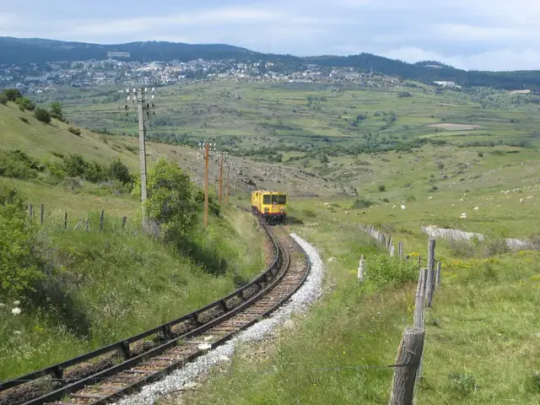
THIRD RAIL
Heavily associated with subways and metros, but used on some suburban surface lines (NYC area, southern England). Also used by three-rail model trains (like Lionel and Märklin).
Low voltage DC for heavy rail use required the use of third rail vs overhead wire due to the conductor thickness required for the high current. They were mostly used on early 20th century lines before catenary and AC power became established. The rails themselves are cheaper to install and maintain vs overhead wire, but they’re notoriously hazardous to humans and wildlife and vulnerable to icing over in winter. They’re also DC-only, which requires more (and more complicated) substations, making the overall price much higher. DC also majorly limits the power of trains they can run (AC can run far higher voltage, we’ll go into this later). They’re well suited to subway use though, since they reduce the tunnel size needed (VERY expensive), distances are shorter and trains are smaller/lighter, and there’s less risk of people/animals getting on the track. On the surface, they’re rarely built anymore and outright prohibited in some areas, and generally being slowly phased out.
I’m prone to giving Electra some kind of third rail pickup since it’s common on multi-voltage electric trains. It’s a funny tie in to how model trains are powered by them and how static buildup on skates can be an annoyance. The CC 40100 locomotives didn’t have one, but some related CC 6500s did for the Maurienne line. Running a nearly 8000 hp locomotive on 600-750 V third rail systems like those around New York City or southern England would result in Electra being laughably weak/slow or just blowing out substations but could make sense for brief backup tunnel use (common in the tunnels around NYC).

Fun bonus: The exception to third rails being DC is actually three-rail model trains, which are usually AC. There’s clearance issues with it on real trains, but it’s okay on that small of a scale/power. The line between how model trains are run and full-sized third rail trains is… thin. Especially when you factor in how some extremely early electric trains ran off two-rail systems exactly like oversized versions of other model trains. A number of issues with regular electric trains also appear in model trains- like incompatible electrification systems and issues due to neglected maintenance. A kid playing with toys is just a sillier microcosm of governments and businesses making rail decisions. Voltage drops in DC power requiring more power sources/substations is also a shared trait, DC model systems often need additional power supplies connected.

OVERHEAD WIRES
The modern standard worldwide, due to their ability to run AC power. I’ll explain that aspect later, but the biggest thing is that AC is leagues better for long-distance power delivery and allows for more powerful trains. Overhead wiring started with simple trolley wires and poles, but the catenary and pantograph setup largely replaced it for heavily applications. Far more expensive to install and maintain than third rail and design problems can plague systems for decades (fixed-wire catenary on the Northeast Corridor causing issues in hot/cold weather, widely spaced poles on the East Coast Main Line leading to more fragility and failures). They also require more vertical clearance, a MAJOR issue in the UK due to their infamously low tunnels and bridges that cause them to have tiny trains in general. They also run into vertical clearance issues with double stacked container trains, though that can be remedied by well cars and purpose-built extra high wires ala India.


The design of catenaries and pantographs is a deep rabbit hole of its own, but it’s pretty easy to mime aspects of them. I’ve seen claims that some of Electra’s common poses were deliberately based on them and I’ve been calling some the “pantograph pose” myself. Raising an arm to represent raising a pantograph, using both arms to represent older style “diamond” pantographs vs single-arm Faivley ones. Lowering one arm and raising the other to represent switching pantographs for different voltages for Electra (the CC 40100 had FOUR pantographs). Using an open hand to represent contact with the wire, coming loose if wire tension is lost and becoming tangled. “Invisible catenaries” are an accepted convention with model trains because making functional ones is incredibly fussy so the wire doesn’t need to be there, just implied. A laser beam might work though. If electric infrastructure were a more important part of the show having catenary poles visible would be plenty to designate electrified vs nonelectrified zones, and so they could be damaged as needed. Trolley poles also aren’t too hard to mime with an outstretched arm and balled fist or twirling fingers for the wheel.
Both catenary and third rail systems have issues of physical inconsistancy and incompatibility between systems even where voltage and frequency match. Stuff like pantograph thickness, over vs under-running third rail adds yet another layer of complexity. That’s something that gets super regional that I don’t know all the complexities of though.

OTHER SYSTEMS: You also have some oddball systems out there like fourth rail on the London Underground and some systems with overhead “third rail” with a rigid conductor that a tiny pantograph touches ala a bumper car on rails. Rail electrification is… a deep rabbit hole and there’s a lot of really weird stuff early on if you dig even a little. Like this wacky three-phase AC railcar with three different pantographs that held the rail speed record for well over a decade in the early 20th century.

My favorite wacky electrification method is just “giant extension cord”. It’s mainly a thing on short industrial/switching yards in Europe but this example is from a mine in Chile and the Milwaukee Road had a homemade corded shop switcher used to pull electric engines from unpowered sheds to the powered main lines. I’m not fully sure how it works logistically but it’s hilarious to imagine and makes sense for very short distances where it’s easier than building and maintaining catenaries.
DC- DIRECT CURRENT
If you use the water metaphor of electricity this is like a constantly flowing river.
DC saw widespread use in trolleys and transit and early heavier rail electrification descended from this (the light/heavy rail divide is more of a spectrum if anything). It was simple and durable for its time (early 20th century) and then-prevalent DC traction motors were simple to power and control with it. It’s harder to implement over long distances due to the higher current needed and greater voltage drop and heat losses vs AC. It requires far more (and more complicated) substations than AC because of this too. AC can also deliver far more power. DC has been gradually replaced with AC where possible, but sheer inertia has made it a slow process and it’s still common in Europe, usually as 1.5 or 3 kV mainlines. There’s also some commuter railroads in the US with DC overhead supplies.
Trains can be pretty easily modified to run on lines lower than their designed voltage, they’ll just be much slower/weaker. Overvolting for short periods of time can increase performance but tends to be damaging in the long term. The latter would be unlikely for a 3 kV-designed train though, since that’s about as high as most DC systems go.
People talk about Electra behaving differently in AC vs DC modes, which is an interesting concept, but going off the CC 40100… yeah it didn’t make a difference since it was designed around running on 1500 V DC, the lowest voltage it took. Newer trains tend to be mostly designed for modern AC lines and are notably less powerful on DC.
The main difference would be… being more “digestible” for DC-motored trains? Tech limits made converting AC to DC difficult in the early 20th century and being able to process it more efficiently was a huge step up. Musically I think DC power would be more associated with Western convention since it mostly developed in the US and western Europe, and player piano ragtime is basically the default trolley/interurban ambiance music.
Another more abstract, but interesting direction for DC mode would be the “ever onwards” mindset electrification has to have when faced with the back and forth of political will… kind of like how a rectifier “straightens out” forward and back AC to DC
AC- ALTERNATING CURRENT
is usually described as “like rising and falling tides” or “a reciprocating pump pushing water back and forth” in the water analogy.
Transformers are the main reason why AC is so dominant in powering trains (and electricity transmission in general). They can “step down” very high voltages, which are more efficient for transmission than lower ones. Basically, it’s easier to deliver more power to trains and requires fewer, cheaper substations. The main issue is converting that AC to a usable form, and technology limits related to that have had HUGE impacts.
Early AC trains often had “universal” AC/DC traction motors that required unusually low AC frequency to run, 25 Hz or less, which is too low for residential use and needed specialized equipment for generation or conversion. It also requires heavier transformers in trains, but this isn’t as much of an issue since especially in the modern day, electric trains tend to be too light if anything. Airplanes often use 400 Hz AC for the opposite reason though, they need the weight savings of the extra light transformers. Around the mid-20th century, rectifiers became practical and it became feasible to use 50/60 Hz mains frequency for trains. Most lines built after that have been that way. But a lot of those earlier lower-frequency lines still exist due to the hassle in changing all that equipment vs just making dual/triple/quadruple voltage trains. It’s like making tilting trains for old, winding rail lines vs building new straighter ones.
Which is why being able to change frequency is an important feature for Electra! Going over/under design frequency will damage equipment and trains will stop if they detect it. Which is why I say that Electra and basically all other AC trains notice the frequency of light flickers and have perfect pitch because being able to detect exact frequency is like telling if food’s gone off for them.
Musically I want to associate AC trains with Serbian music as a reference to Nikola Tesla and because you sometimes get some vaguely similar fluttering, bagpipe-like sounds from AC motors. Balkan folk music is a fascinating rabbit hole in general and was popular in the prog rock sphere for how it sounds so alien to western audiences.

AC vs DC: TRACTION MOTOR EDITION
Oh great, another layer of complexity with the AC vs DC thing, because this is also important.
AC motors are superior in basically every way and DC motored trains aren’t made much anymore. Many of those that remain have been rebuilt to AC motors. They’re lower maintenance and more efficient and powerful. But before semiconductor technology, it was hard to control AC vs DC motors, so they didn’t become more widespread until the later 80s. You’ll see some very old mountain drag freight electrics (N&W electric engines, PRR FF1) with three-phase AC motors that could basically just go one constant speed, which worked for that job and not much else. They are about the peak of being “big dumb lugs” for lack of a better descriptor. Universal AC/DC motors were also common in the early 20th century.
DC motors have brushes that are more hassle to maintain and run hotter. As said above, they are easier to control with older tech though. It’s done by varying voltage with a combination of resistors and running motors in series vs parallel (look into Frank Sprague’s work on trolleys for details). Regenerative braking isn’t possible on engines with AC/DC rectifiers since they’re a one-way device, so many have dynamic brakes. Dynamic braking is done by just sending that excess electricity through a huge variable resistor, like a giant toaster or space heater. And that’s why DC-motored trains often have infamously loud fans (see the BR Class 91). It’s pretty much fact that Electra would sound like an overheating computer as an 80s-era locomotive. I see Electra as at least initially DC-motored and maybe converted to AC motors in midlife, around 2000.
Bonus: AC motors after the 90s or so are controlled by variable frequency drives and make lots of fun noises depending on tech.
MODEL TRAINS
The line between how model trains work and full-sized electric railways is… surprisingly thin, especially early on. Toy trains with onboard batteries have been a thing for years, of course. But because electric toy trains existed before household electrification was prevalent or standardized, many of those had separate battery packs that powered the track vs plugging into a wall. Not unakin to how some early electric railways were run. Two-rail electrification (one rail positive, one negative) used on many model systems was used on some very early tramway systems, though it was vulnerable to being shorted by kids placing rods across it or frying women in long, soggy skirts and didn’t last long.
Lionel uses a third-rail system similar to that on subways and commuter lines, though with a centrally placed rail. Märklin has stud contacts for similar purposes. Both are the big, weird exception to all third rails being AC- the vastly lower voltage remove the voltage issue.
Two-rail systems can be DC or AC (usually for DCC). DC has similar issues to voltage drop as on full size lines. It was also the standard for years due to ease of control, varying the voltage on a controller changing the speed of the locomotive and flipping the positive/negative reverses it. DCC is used for more precise control of multiple locomotives today. Compatibility between the two is an issue, trains can be converted to work on the other system but running DC motors on AC only works when done a specific way, and if left to idle for long they’ll just go back and forth and burn out.
Building tiny catenaries for model trains exists and is incredibly fussy and niche. Model with functional pantographs are common, but making and running the actual system is often very frustrating even for experienced adults so it’s rare to actually use. It’s something I’ve even seen people who work in actual rail electrification balk at because of the tiny scale of it, but it reportedly has similar issues with pantograph contact and pressure and wires breaking, with the bonus of way more derailing and corrosion issues that require frequent cleaning to prevent due to the tiny contact area
PUTTING IT ALL TOGETHER
Here’s a relevant news story that’s got… battery and non-battery electric locomotives AND EMUS AND bimodes, and five seperate electrification systems ft. several different DC third rail and AC overhead voltages/frequencies. All it’s missing is DC overhead, which I don’t think even exists in this region anyways.
So go forth and use some of the more unique tendencies of electric trains. If you do it on even a surface level you’ll be ahead of 90% of the rest because this stuff is just ignored or batterywashed SO much in Anglophone media. I was going to include a section on power electronics evolution in regard to them but that’s going to go in a separate post. They’re important to why use of AC power was limited
Main sources: William Middleton’s “When the Steam Railroads Electrified” and this video by a longtime Amtrak employee.
Also see above article for more sources on the northeast US and lots of specific numbers. And anything by Clive Lamming is great for personifying this topic, especially if you know French.
24 notes
·
View notes
Photo

Portuguese Brazil
With a wealth of natural resources, Brazil was by far the most important colony in the Portuguese empire and was, at one time or another, the world’s leading producer of sugar, diamonds, and tobacco. Colonised from the 1530s, most settlements were coastal towns until the interior was exploited bringing further conflict with the Amerindians.
Importing a massive number of slaves from Africa, Brazilian society became multicultural but remained dominated by white Europeans. The colony was repeatedly threatened militarily and commercially by the French, Dutch, and British, but Portugal held on to its jewel in the colonial crown until Brazil achieved independence in 1822.
Europe Discovers Brazil
Vasco da Gama (c. 1469-1524) famously sailed around the Cape of Good Hope and on to India in 1497-1499, giving the Portuguese access to the spice trade of the East. The Portuguese followed this up by creating an empire of trading ports that went from East Africa to Japan. One of the by-products of da Gama’s epic voyage was significant for Brazil on the other side of the world. Da Gama had pioneered a new route to sail down the Atlantic Ocean to gain favourable winds. It was a risky strategy that involved sailing far out into the mid-Atlantic. When Pedro Álvares Cabral set off to repeat da Gama’s feat in March 1500, he sailed too far west and accidentally 'discovered' Brazil (although the visit may have been planned by the ever-secretive Portuguese). Cabral stayed eight days at Baia Cabrália where he met Amerindians. A Spanish sailor, Vicente Yáñez Pinzón had perhaps been the first European to sight the Brazilian coast the year before, but it is not clear where exactly he went. In any case, it was the Portuguese who claimed Brazil for their own because, as had been agreed with Spain in the 1494 Treaty of Tordesillas, it was within their sphere of influence. A second Portuguese expedition, led by Gonçalo Coelho, explored the Brazilian coast in more detail in 1501. Another famous explorer, the Florentine Amerigo Vespucci (1451-1512), visited in 1502, and he gives the following description:
This land is very delightful, and covered with an infinite number of green trees and very big ones which never lose their foliage, and through the year yield the sweetest aromatic perfumes and produce an infinite variety of fruit, gratifying to the taste and healthful to the body…and the fields produce herbs and flowers and many sweet and good roots, which are so marvelous…that I fancied myself to be near the terrestrial paradise.
(98)
The name Brazil, which first appears on maps from 1511, may derive from 'Bresel wood' which was a popular hardwood of reddish colour exported from India to Europe in the Middle Ages. A similar type of wood was common in the forests of Brazil. Alternatively, the source may be brasa, the Portuguese name for this dark redwood and its dye which means 'glowing coal'. One of the early successful exports from Brazil was these hardwoods, used in everything from ships to violins. This timber attracted private Portuguese traders to Brazil from 1502 who established the first trading station (feitoria) north of Rio de Janeiro.
In 1511 the Portuguese Crown, wary of interest from Spain, made an official but secretive move on Brazil. João de Lisboa and Estêvão Froes commanded two caravel ships which explored the Brazilian coast. Spain sent a fleet to do the same in 1515. Both nations were looking for a route around the southern tip of the Americas and access to Asia. The Portuguese explorer Ferdinand Magellan (c. 1480-1521), in the service of Spain, was the first to achieve that feat on his 1519-22 expedition that circumnavigated the globe. Spain may have gained access to the Pacific Ocean, but it was Portugal that got to work on colonizing Brazil.
Continue reading...
39 notes
·
View notes
Text
Elon Musk is threatening a Brazilian Supreme Court justice after the court issued a summons to him which threatens the suspension of Twitter if he does not comply within 24 hours.


To combat disinformation, Brazil gave a Supreme Court justice sweeping powers to order social networks to take down content he believed threatened democracy. Here's how the experiment led to a ban on X, the social network owned by Elon Musk.
https://www.nytimes.com/2024/08/31/world/americas/brazil-x-ban-free-speech.html?smid=threads-nytimes



Elon Musk claims this is a censorship, because previously he was ordered to ban and close a lot of far-rights account that spread fake news and hate online by that same judge. As protest, Musk closed X offices in Brazil - which means people losing their job or their income.
When free speech is interpreted as anything which matches the law (and viceversa). Under Elon Musk's Leadership, Twitter has approved 83% of censorship requests by authoritarian governments globally. The social network has restricted and withdrawn content critical of the ruling parties in Turkey and India, among other countries, including during electoral campaigns.
Since Musk assumed control in October 2022, the platform has received a total of 971 government requests, a significant increase compared to the 338 received between October 2021 and April 2022.
Prior to Musk's takeover, Twitter had agreed to 50 per cent of such requests, as indicated in their last transparency report. However, no transparency reports have been published since October 2022, making it challenging to assess the current situation. Nevertheless, data from the technology information portal Rest of World suggests that the compliance rate has risen to 83 per cent following Musk's leadership, which again contribute to detect what Elon Musk REALLY think about free-speech: this right is granted only if comply to what oppressive governments and far-right politician approves. Discrimination and criminal behavior are allowed and protected under Musk's Leadership, because targets minorities, immigrants and political oppositors. Musk is a conservative and apply censorship, he isn't the victim of a 'woke' complot lead against him. Musk is receiving the payment for his unlawful action.
Source: El Pais English

As far I can understand, without having many clues here, this order of summon says that Elon Musk refused to appoint a legal rapresentative for X Brasil. For some typology of corporates Brazil require a % of residents in management or a legal rapresentative, with power to vote and deliberate in meetings, to operate online in the country. Yeah. Law apparently seems to be applied to everyone except him.
Summons with translation.


https://www.nytimes.com/2024/08/28/technology/brazil-x-ban-elon-musk.html
Edit: A legal rapresentative is more a managerial position than what do you think of. Yes, it could be an attorney or a lawyer too, but still isn't simply the guy who defend the corporate's interests in court. In Brazil you need a % of residents in management position to operate. This was a problem issued also with WhatsApp and Telegram.
Edit 2 - 31th August 2024: I was curious about the consequences of Musk's decision to close X's offices in Brazil for his employees. Have they been fired? Suspended with or without salary? I didn't find anything. However, I found this article that adds some informations, like Musk declaring he did this to "protect his staff". However, his legal rapresentative is impossible to be found.
Edit 3 - 31th August 2024: Another article of NY Times that analyzes the matter.
https://www.nytimes.com/2024/08/18/world/americas/elon-musk-x-brazil.html
Update - 31th August 2024: Brazil has turned off Twitter. Musk’s genius is again on glorious display in losing the 7th most populous country in the world. Oh well. At least the Cybertruck is doing awesome.
Another Update - 31th August 2024: Musk is freaking out right now. He knows if he gets blocked in Brazil it is just a matter of time before other countries follow suit.
However, someone forgot to tell Musk that you get fined for using VPNs to access Twitter in Brazil before he posted this.
Also seems that for a tech genius Musk isn't very smart though, doesn't he know using a VPN will worth the same with apps as it does with a browser?

However, The Brazilian Supreme Court has moderated its first rule. First, even the VPN apps were targeted and should be banned from App store and Google Store to prevent people getting access to Twitter exclusively. Now, the Court realized that banning VPNs is too extreme, so they will only apply a 50k (about $8,900) fine for those caught accessing the platform.
Basically, you don't get fined for using VPNs, that would be too 1984. You might get fined if they FIND OUT that you're accessing X via VPNs, and this is exactly the kind of thing VPNs are designed to prevent.
Just a reminder, you can always access better platform than X, even on your phone. No app is needed.
VPNs are great tools to use worldwide to get around authoritarian and abusive government surveillance and blocking. Zero to do with Musk. And they can only catch you if you aren't savvy.
In a perfect world you shouldn't need to download any VPNs to access innocent contents, because democratic countries will never block a platform that gives informations and entertainment to people. In a perfect world you won't be stuck with platforms that are not free from disinformation and neo-nazi posts.
3rd Update - 31th August 2024:
Musk owns more of SpaceX than Zuck owns of Meta or Bezos owns of Amazon, fwiw. For all intents and purposes, Musk is Twitter, SpaceX, Neuralink and X.

I'm gonna add some technicalities here:
In Brazil there is something called "Corporate Personality" that protects the shareholders patrimony from the company's debts.
But... If you hide behind legal shenanigans in a fraudulent manner, "corporate personality" is bypassed and thus the court moves into your personal patrimony.
Elon is, personally and fraudulently, removing X office from Brazil so they don't obey Brazilian laws.
So the judges target him on his other shares: SpaceX and Starlink.
#vavuskapakage#elon musk#all my homies hate elon musk#elongated muskrat#fuck elon musk#fuck em#fuck elongated muskrat#elon musk is an idiot#elon musk is a fraud#elon musk is a moron#brazil twitter#twitter#x twitter#twitter x#twitter brazil#twitter ban#twitter brasil#fuck twitter#elon musk is an asshole#elon mask
84 notes
·
View notes
Text
EXCLUSIVE: One year ago we told you that a second season of John le Carré adaptation The Night Manager was quietly being developed under the codename Steelworks.
Now, Deadline can reveal that the BBC and new co-pro partner Amazon have gone big on a supercharged two-season order of the thriller, with Tom Hiddleston returning to lead, Hugh Laurie coming back as EP and with a new director in I Hate Suzie’s Georgi Banks-Davies. A third season has also been greenlit. David Farr returns as writer and Stephen Garrett is showrunner.
The Night Manager Season 2 will begin filming later this year and will pick up with Hiddleston’s Jonathan Pine eight years after the explosive finale of Season 1, going beyond the original book, which was written by the celebrated British writer in 1993. Additional plot details are being kept under wraps and there is not yet confirmation as to whether EP Laurie’s Richard Roper, who was last seen in the back of a paddy wagon driven by arms buyers who were not best pleased with him, will return to star. Hiddleston will also EP and will discuss in more depth on tonight’s Jimmy Kimmel Live!
Produced by The Ink Factory in association with Character 7, Demarest Films and 127 Wall, and in co-production with Spanish partner Nostromo Pictures, The Night Manager Season 2 was sold to Amazon by Fifth Season. The first was co-produced with AMC.
New director Banks-Davies, a BAFTA-nominee who takes over from Susanne Bier, has credits including I Hate Suzie, Garfield and upcoming Netflix series Kaos.
The Night Manager Season 1 was a huge success, watched by millions and winning multiple BAFTAs, Emmys and Golden Globes including best actor for Hiddleston. Also starring Tom Hollander, Olivia Colman and Elizabeth Debicki, it followed Pine – who ran a luxury hotel in Cairo – as he attempted to infiltrate the inner circle of Roper’s crime syndicate after being hired by Foreign Office task force manager Angela Burr.
The first season was commissioned more than 10 years ago and the show has since been remade in India, lapping the UK version by swiftly having a Season 2 greenlit for Disney+ Hotstar in May last year.
Simon Cornwell and Stephen Cornwell, le Carré’s sons who run The Ink Factory, said Season 1 proved “a landmark moment for the golden era of television – uniting on-screen and behind-the-camera talent at the top of their game – and an audience reception which was beyond our wildest imagining.”
They added: “Revisiting the story of Pine also means going beyond the events of John le Carré’s original work: that is a decision we have not taken lightly, but his compelling characters and the vision David has for their next chapter were irresistible.”
Amazon MGM Studios Head of Television Vernon Sanders said: “We are elated to bring additional seasons of The Night Manager to our Prime Video customers. The combination of terrific source material, the wonderful team at The Ink Factory, a great writer in David Farr, an award-winning director in Georgi Banks-Davies, as well as the talented cast truly make the series the full package.”
Hiddleston said: “The first series of The Night Manager was one of the most creatively fulfilling projects I have ever worked on. The depth, range and complexity of Jonathan Pine was, and remains, a thrilling prospect.”
BBC content boss Charlotte Moore added: “After years of fervent speculation I’m incredibly excited to confirm that The Night Manager is returning to the BBC for two more series.”
The Night Manager series two is created and executive produced by Farr, based on the characters created by le Carré. Additional executive producers include Garrett for Character 7, Banks-Davies, Laurie and Hiddleston; Joe Tsai and Arthur Wang for 127 Wall; Stephen and Simon Cornwell, Michele Wolkoff, and Tessa Inkelaar for The Ink Factory; Adrián Guerra for Nostromo Pictures; William D. Johnson for Demarest Films, Nick Cornwell, Susanne Bier, Chris Rice for Fifth Season and Gaynor Holmes for the BBC.
#tom hiddleston#the night manager#seasons 2 and 3#official#jonathan pine#hugh laurie#booked and busy
99 notes
·
View notes
Text

An unprecedented female monarch in her dynasty, Rudrama Devi (r.1262-1289) presided over an age of prosperity. A successful warrior queen, she triumphed over both internal and external threats.
Her father’s heir
Rudrama Devi was the daughter of King Ganapati Deva (r.1199-1262) of the Kakatiya dynasty, who ruled over parts of present-day Telangana and Andhra Pradesh in Southern India. Their capital was located at Orugallu (Warangal).
Ganapati Deva was a successful monarch. His kingdom was famed for its’ diamonds and beautiful fabrics. He had no son to succeed him and his older daughter was already married. He thus decided to make his younger daughter Rudrama Devi his heir and gave her the requisite training.
A female monarch would nonetheless be a in vulnerable position and see her legitimacy questioned. To make female rule more acceptable, he arranged a Putrikayagna ceremony for his daughter. This religious rite allowed a sonless man to declare his daughter or his daughter’s son as his son. After that, Rudrama Devi was also known by the masculine name of Rudra Deva. She also attended all public meetings in masculine attire.
Her story is similar in that regard to that of her near-contemporary, Raziya Sultan of Delhi.
A warrior among warriors
In 1259, Rudrama Devi became her father’s co-ruler and assumed sole rule in 1262. She married the Chalukya prince Virabdhadra, who played no part in her administration, and with whom she had three daughters.
Rudrama Devi faced many threats at once. Her neighbors saw an opportunity to conquer her kingdom and her feudatory noblemen couldn’t stand being ruled by a woman.
She stood her ground and prevailed, proving her might as a warrior queen. Many of her nobles rebelled, but she successfully defeated them. The Seuna Yadava king, Mahadeva, invaded her territories and reached her capital. Rudrama Devi chased him after 15 days of fighting and forced them to pay a heavy tribute in money and horses.
To commemorate her victory, she styled herself “Rayagajakesari” or “the lion who rules over the elephant kings”. In the pavilion she built, she was depicted as a warrior mounted on a lion, holding a sword and a shield, with an elephant trunk holding up a lotus to her in sign of submission.
In 1262, another of her neighbors occupied the Vengi region. She was able to recover it after 12 years of fighting. She was nonetheless unsuccessful in fending off the attacks of her southern rival Ambadeva.
Meritocratic policies
Rudrama Devi completed the construction of the nearly impregnable Warangal Fort. She bought large tracts of land under cultivation, increasing her kingdom’s revenue. She also recruited non-aristocratic warriors from diverse castes. Only 17 percent of her subordinates were of noble background. Prominent commanders could receive lands and become feudatory nobles. She thus established a new warrior class. Since the nobility had rejected her rule, this meritocratic policy allowed her to surround herself with loyal retainers.
Marco Polo, who mistook her for a widow of the previous king, wrote about her very flattering terms, calling her a “lady of much discretion” and a “lover of justice, of equity and of peace”.
A warrior to the end
At the end of her reign, she chose her grandson, Prataparudra, as her heir.
Rudrama Devi likely died in 1289 (though some sources date her death from 1295) according to an inscription made by a member of her army commemorating her recent death and that of her army chief. The cause and location of her death are unknown. She likely died facing Ambadeva's armies, leading her troops as she had always done.
Further reading
Gupta Archana Garodia, The women who ruled India, leaders, warriors, icons
Janchariman M., Perspectives in Indian History From the Origins to AD 1857
Talbot Cynthia, "Rudrama‐devi, Queen of Kakatiya dynasty (r. 1262–1289)", In: The Oxford Encyclopedia of Women in World History.
Talbot Cynthia, Precolonial India in Practice: Society, Region, and Identity in Medieval Andhra
#rudrama devi#13th century#history#women in history#women's history#historyedit#women's history month#india#indian history#queens#powerful women#women warriors#warrior women#historical figures#herstory
98 notes
·
View notes
Text
Devastating Fire in Kuwait Claims Lives of 42 Indians in Mangaf
A devastating fire in a residential building in the Mangaf area of Kuwait has resulted in the tragic deaths of 42 Indian nationals. The fire broke out in the early hours of June 13, 2024, causing widespread panic and significant loss of life.
The building, which housed multiple families and workers from India, was engulfed in flames quickly, trapping many inside. Despite the prompt response from the Kuwait Fire Service Directorate (KFSD), the intensity of the blaze made rescue operations extremely challenging.
Eyewitnesses reported hearing cries for help as the fire rapidly spread through the building. “It was horrifying. The smoke was everywhere, and people were screaming,” said a nearby resident. The cause of the fire is still under investigation, but initial reports suggest it may have started due to an electrical short circuit.
The Indian Embassy in Kuwait has confirmed the casualties and expressed deep sorrow over the incident. In a statement, the embassy said, “We are deeply saddened by the tragic fire in Mangaf that has claimed the lives of 42 Indian nationals. Our thoughts and prayers are with the families of the victims. We are working closely with Kuwaiti authorities to provide all possible assistance.”
The local authorities have set up an emergency response center to assist the affected families and coordinate relief efforts. The Kuwaiti government has also promised a thorough investigation into the incident to determine the cause and prevent such tragedies in the future.
Prime Minister of India, Narendra Modi, expressed his condolences on social media, stating, “Deeply saddened by the loss of lives in the tragic fire in Kuwait. My heartfelt condolences to the families of the victims. We are in touch with the Kuwaiti authorities and will extend all necessary support to the affected families.”
Many of the victims were reportedly workers who had come to Kuwait in search of better job opportunities. The Indian community in Kuwait is in shock and mourning the loss of their fellow countrymen. Community leaders have called for immediate support and assistance for the families of the deceased.
The incident has highlighted the need for improved safety measures in residential buildings, especially those housing expatriate workers. There have been calls for stricter enforcement of fire safety regulations to prevent such tragedies in the future.
As the investigation continues, the priority remains on providing support to the victims’ families and ensuring that those injured receive the necessary medical care. The Indian Embassy has set up a helpline for information and assistance.
This tragic event has cast a pall of grief over the Indian community in Kuwait and serves as a stark reminder of the importance of safety and vigilance in preventing such disasters.
#werindia#leading india news source#top news stories#top news headlines#top news of the day#Mangaf#Kuwait fire#Kuwait Mangaf tragedy
2 notes
·
View notes
Text
Study: Protecting the ocean helps fight malnutrition
"Protecting more of the ocean could slash the risk of malnutrition for up to 3 million people worldwide, according to a new study co-authored by Conservation International.
It found that fish catches in coral reefs could increase by up to 20 percent by expanding sustainable-use marine protected areas — that is, areas where some fishing is allowed with restrictions.
The benefits of marine protected areas in helping restore fish populations and ecosystems are well documented. However, perceptions persist that these protections come at the expense of local communities.
The new study challenges this view.
“It’s easy to think of protected areas as putting people and nature in conflict by restricting access to much-needed sources of nutrition for locals,” said Conservation International scientist Alex Zvoleff, a study co-author. “But what this study shows is that protecting nature isn't about walling off resources from people; protected areas can actually enhance what nature provides for people."
The study analyzed fish counts in nearly 2,500 coral reefs across 53 countries, focusing on the nutrients found in fish that are critical for human health. Researchers looked at sites with a range of protections — from complete bans on fishing to open access for fishing — and found that sustainable-use marine protected areas have on average 15 percent more fish biomass than non-protected areas.
The study pinpointed countries with the greatest potential to improve malnutrition through sustainable-use marine protected areas, including Bangladesh, India, Indonesia, Kenya, Madagascar, Mozambique and Nicaragua.
More than 800 million people face malnutrition worldwide, according to the World Health Organization. In many coastal communities, fish can be the only source of vital nutrients — particularly for children and pregnant women.
However, pollution, overfishing and climate change are severely degrading the coral reefs that support these fish. And though coastal communities make up a small portion of those struggling with malnutrition, the study shows that fighting food insecurity can go hand in hand with protecting nature, said Daniel Viana, the study’s lead author.
“There is often a push for marine protected areas to completely ban fishing — our goal is to show that it does not need to be all or nothing,” Viana said. “Allowing regulated fishing in marine protected areas can support healthy fish populations, while also having a positive impact on the quality of life of surrounding communities.”
The study’s findings are particularly significant as global efforts are under way to protect at least 30 percent of the planet’s land and marine ecosystems by 2030. Currently, only about 8 percent of the ocean is protected."
-via Conservation International, September 17, 2024
#malnutrition#food insecurity#oceans#marine protected area#30 by 30#tidalpunk#public health#nutrition#good news#hope
231 notes
·
View notes
Text
Keepers of the Quaich
This time, we're going to look at things a bit differently and this could very well be my most speculative post ever. So be it: it is a risk I am taking and warning you about from the get go.
The only thing Mordor understood about the next October 4 event organized by the US Chapter of The Keepers of the Quaich is something that probably gave them collective relief: S is not going to be with C on her birthday. Not together. Not on the same continent. Shut up, shippers, you are stupid.
As usually, Mordor takes things at a very primitive face value, without bothering for context. But they always focused on the lewd side of the story, not on its deep ramifications, of which there are many. Anything that denies S's halfwit manwhore image upsets them greatly.
The Scottish society of The Keepers of the Quaich is not one of those old, steeped in tradition clubs, but it is damn selective. It only dates back to 1988, which is almost five minutes ago, for Europe (and especially the UK) and is deeply rooted in Highlands' lore, celebrating excellence in whisky trade and promotion worldwide. General facts about it have already been discussed elsewhere, but with a bias and little to no context. Also, really LOL at Mordor's idiocy to think that was a fan promotion event and go ballistic for the members-only and by invitation access to it.
Membership is by co-opting and with a five-year proven performance history only (ten years, if you step up to Master level). You need not one, but two recommendations, which makes it harder to join than a Masonic lodge or the Rotary Club (and I know what I am saying, heh). That S could actively seek to be inducted, rather sooner than later, is pretty much clear, as he could use the network it readily provides, along with the prestige:

(Sourced at: https://www.diffordsguide.com/encyclopedia/341/people/keepers-of-the-quaich)
I first had a look at the list of its International Chapters and it is interesting to notice Muslim countries as Turkey or the Emirates each having their own chapter, which clearly tells me it's all about luxury and more specifically, luxury hospitality business, in that case. If inducted after the customary five years' wait, S could also make good use of the German chapter's (a market that proved to be very problematic for him) network, along with the Nordics and Netherlands, if he would think about cleverly expanding his trade in the EU. Last but not least, I would keep an eye on Brazil and India (along with the more predictable South Africa and Australia), because he already has a solid fanbase in the first one and well, Asia is always interesting, when it comes to alcohol business.
I did not really bother with the list of the Patrons, which spells a good and prestigious sliver of Debrett's Peerage's Scottish section. But I also looked at the list of the Management Committee, who does all the hands-on dealings and is directly responsible for the induction ceremony of new members. Aside from representatives of Diageo and Pernod Ricard (giants of the alcohol business world), a familiar name popped right at the bottom of the page:

Annabel Meikle, Director of The Keepers of the Quaich and as such, directly involved in the management of its activities (and probably also in all the underground shenanigans leading to the induction of new members, too). A great contact to have in your rolodex, judging by her public CV on LinkedIn:
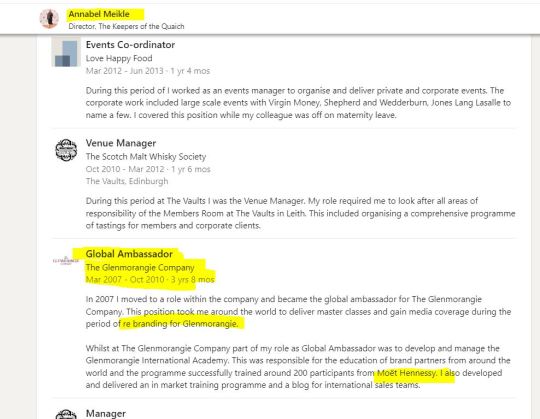
Glenmorangie (also a member of the Keepers) - keep that reference under your sleeve, we are going to need it soon :).
Could she be related to...

I am leaving this without an answer, because I don't know and I will always refuse to go data mining for anything, but that sure as hell is not a common surname, as Smith or Martin!
At any rate, Mrs. Meikle is also (along with the Duke of Argyll, the current Keepers Grand Master) a member of The Scottish Committee of something very, very prestigious: The Worshipful Company of Distillers (https://www.distillers.org.uk/), based in London and founded in 1638, by Royal Charter (for “Body Politique and corporate” to govern the “Trade Arte and Mystery of Distillers of London” - how I love history, people!) granted by Charles I, a Stuart (of course). I am speculating and having visions of Livery status and Freedom of the City, followed by Knighthood for S (no bong needed, this particular narrative writes itself and believe it or not, it's not entirely without logic). And it is my strict constitutional right to be a poetic coo about it - that guy is smarter than we thought and I would curate that contact to death if I were him (but I am not, I am just a benevolent and intrigued observer, as you all know). Back to Earth from these optimistic conjectures, I will keep a tab on it, as I dutifully took note that one of their current interests is tequila:

Onwards to the US. We can have a fair idea of October 4th event just by looking at one of their few press releases on the occasion of the Chapter's launch gala, on September 25 2019, in New York (https://www.distilledspirits.org/wp-content/uploads/2019/10/KOTQUSA-Release-10.04.19.pdf - with quotes selected by me):



Moët Hennessy. Another reference to keep under our sleeve, for it will be soon very relevant. So yes, what has been speculated by Miss Marple is partially true: more business than aristocratic. But this is only if we do not consider as American aristocratic the venue of the next event. The Metropolitan Club is a very East Coast, WASP old money and (well, technically yes) Republican (but not MAGA Republican and this, to me, is very important for some reason) organization:
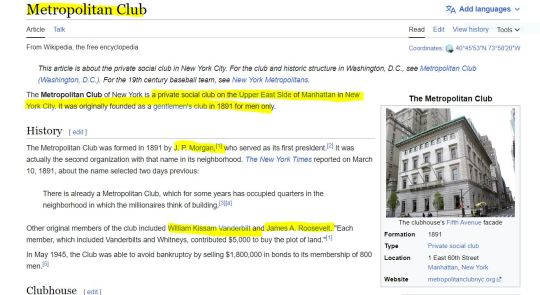
That was the state of play on Friday, folks, and I was already excited to share my optimistic findings with you. And then, C went to Paris and more dots started to speculatively connect. Bare with me for this long passegiata, I think it's worth it.
It was particularly important that C would be seen in a very friendly-casual pose with Delphine Arnault, out of all the other people attending that event. Not because Arnault is currently the big boss of Dior and Loewe (as I already explained here: https://www.tumblr.com/sgiandubh/729801825900953600/city-of-lights?source=share). And not only because C suddenly seems very interested to renew and expand her fashion days' old network. But also, because, as I already said, Delphine Arnault is also the daughter of her father and in France, business and family are always closely entwined. Always.
The French luxury market is roughly split between two behemoth players: Bernard Arnault (LVMH Moët Hennessy • Louis Vuitton S.A) and Antoine Pinault (Kering, ex- Pinault-Printemps- Redoute). These people and their businesses are number 1 and 2, respectively, on the global market. And out of these two, the only one very interested in the alcohol business is Arnault (Pinault does not deal in this sector).
So I took a look at his very diverse alcohol and spirits brand portfolio (25 references - https://www.lvmh.com/houses/wines-spirits/): rhum, brandy, champagne, tequila, wines (Argentina and even China). Two Scottish whisky brands: first Ardberg (the graceful peat from Islay). And - oh, hello, Mrs. Meikle - Glenmorangie, acquired by Arnault in 2004, after a bitter battle with Pernod Ricard (https://www.nytimes.com/2004/10/21/business/world-business-briefing-europe-france-scotch-maker-acquired.html):

Back at Mrs. Meikle's CV - hers was a pivotal role in the post-acquisition reshuffle, as part of LVMH:
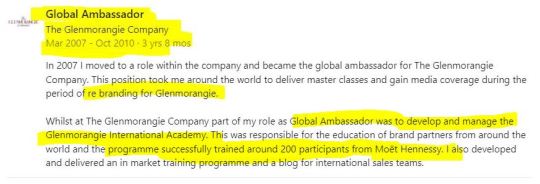
Coincidence? I think not.
And then also a bourbon reference. Woodinville (based in the state of Washington, USA) with a pitch that made me grin again like the Cheshire Cat:

Sounds familiar? Rings a bell? See a pattern? You should: no, it's not S in disguise, but it could be SS in a couple of years, if S decided to sell it for a hefty profit.
But I was also interested in what is missing from this catalogue.
NO GIN.
Who knows? Maybe these French people could be enticed? In that case (and remember: I am SPECULATING), it would have to be a brand with a proven track record. You see, Arnault is famous for always buying only brands with a proven history and proven recognition (Tasting Alliance, anyone? LOL). Up until now and as is, FMN is just a pet project and a virtual endeavor. Nothing more and we shall see. But that little wild Scottish gin which could win hearts and already an award in Frisco is something completely different.
Now, then. You connect the dots. You draw your own conclusions. I see something very intriguing here and, as I already told you, the business underground situation is completely different from the bland façade.
You see, this is not about papers or checking a pulse or awkwardly grabbing a fist on some stairs. This is show me the money time. This is all about finding unexpected connections, at a very high level and on a very narrow niche.
So you think S and C can't stand each other anymore?
Humbug. They have each other's back from Day 1. And more. Ship on, ladies. Whatever clownery these days might bring, I know what I know. And by now, you should start asking yourselves the real questions, not if Waldo is with Carmen Sandiego (we KNOW), nor if they were online at the same time or not. I mean, that's cute: but to be honest, I think we're past that... uh... waypoint?
Next on my list is that Lallybroch trademark thing. This is the most complex one and I will take my time. I may speculate, but never without a logical base. And I always take these things very seriously.
Keepers of the Quaich, indeed. :)
247 notes
·
View notes
Text

EXCLUSIVE: After breaking out with her lead role in the second season of Netflix’s smash hit series Bridgerton, Simone Ashley has moved on to star in This Tempting Madness, a new indie directed by Jennifer E. Montgomery, from her script written with husband Andrew M. Davis, which just wrapped production in Los Angeles.
A first look still from the pic, marking Montgomery’s feature directorial debut, can be found below.

Inspired by a true story, This Tempting Madness is an elevated psychological thriller about a young woman (Ashley) who awakens from a coma grievously injured, memory fractured, her husband arrested. But as she puts together the pieces of her past, she starts to question her own actions — and her perception of reality.
Producers include Montgomery and Davis for their Smoke Jumper Films; Mango Monster Productions; Jessica Malanaphy and Marcei Brown for CatchLight Studios; and William Day Frank. Coming from a background as a cinematographer, Davis will also be lensing the film.
In the second season of Bridgerton, based on the hugely popular Julia Quinn romance novels, Ashley was introduced as Kate Sharma, who’s courted by Viscount Anthony Bridgerton (Jonathan Bailey) upon her arrival in London from India. For a moment snatching the record of the most-watched English-language series in Netflix history, with 251.7M hours viewed in its first seven days, the season was celebrated for breaking a race barrier with Ashley’s character, whose ethnicity was changed from the books so that her family would be of Indian descent.
Set to reprise the role in Season 3, Ashley has also recently appeared in Disney’s live-action reimagining of The Little Mermaid, as Ariel’s sister, Indira. Otherwise best known for her role as Olivia on Netflix’s BAFTA-winning series Sex Education, she also boasts credits including Pokémon Detective Pikachu (Warner Bros), Broadchurch (BBC America) and C.B. Strike (Cinemax), to name a few. The actress is represented by Identity Agency Group, CAA, and Myman Greenspan Fox.
Montgomery and Davis are repped by Anonymous Content.
Source: Deadline
#simone ashley#bridgerton#kate sharma#dailywoc#southasiansource#wocdaily#ladiesofcinema#wonderfulwomendaily#wonderfulwoc#femalestunning#wifesource#dailybridgerton#dailyfemale#femaledaily#dailykanthony#dailypoc#this tempting madness
135 notes
·
View notes
Text
Guest essay by Gregory Wrightstone
As the love affair with so-called green energy cools and “net zero” commitments to eliminate “carbon emissions” wane, we see glimmers of acknowledgment for the benefits of carbon dioxide. That’s right: More people are beginning to understand that the gas – widely demonized as a pollutant endangering Earth with excessive heat – is a life-giving substance needed in greater amounts.
U.S. voters know that President-elect Donald Trump has declared the Green New Deal a “scam” and promises to return common sense to environmental regulations and energy development. His return to office rests partly on that pledge.
In Europe, German politicians whose green fetish has produced economic decline face serious electoral challenges. And developing countries like India ignore “decarbonization” promises to aggressively develop coal mines and import more of the fuel to spur growth and eradicate poverty.
Less frequently reported is the story of carbon dioxide emissions greening the Earth and boosting crop production. Educating the public on the benefits of carbon dioxide is the mission of the CO2 Coalition, which I lead. We sponsor speakers and publish scientifically based materials for adults and children. Much of the information is about the role of CO2 as a beneficial greenhouse gas in moderating the extremes between daytime and nighttime temperatures and as a photosynthetic plant food.
“Fossil Fuels Are the Greenest Energy Sources” by Dr. Indur Goklany is an example of our work. Did you know that up to 50% of the globe has experienced an increase in vegetation and that 70% of the greening is attributed to plant fertilization by carbon dioxide emissions from fossil fuels? Or that nearly 200,000 square kilometers of the southern Sahara have been converted to a lush grassland from desert?
Few have heard that doubling atmospheric CO2 from its current concentration of 420 ppm would significantly increase agricultural productivity and have little effect on the climate.
It appears that some of this knowledge has reached Canada because Alberta’s ruling Unified Conservative Party (UCP) recently approved a resolution that promotes the salutary effects of CO2 and endorses an outright rejection of the national government’s net zero policy.
“It is estimated that (atmospheric) CO2 levels need to be above 150 ppm (parts per million) to ensure the survival of plant life,” says the proposal for a resolution eventually adopted by the party. “The Earth needs more CO2 to support life and to increase plant yields, both of which will contribute to the health and prosperity of all Albertans.”
The UCP calls for abandoning CO2’sdesignation as a pollutant and for recognizing the gas as “a foundational nutrient for all life on Earth.”
19 notes
·
View notes
Text



Supercomputer simulations of giant radio galaxy formation challenge current theoretical models
Enabled by supercomputing, University of Pretoria (UP) researchers have led an international team of astronomers that has provided deeper insight into the entire life cycle (birth, growth and death) of giant radio galaxies, which resemble "cosmic fountains"—jets of superheated gas that are ejected into near-empty space from their spinning supermassive black holes.
The findings of this breakthrough study were published in the journal Astronomy & Astrophysics, and challenge known theoretical models by explaining how extragalactic cosmic fountains grow to cover such colossal distances, raising new questions about the mechanisms behind these vast cosmic structures.
The research team—which was led by astrophysicist Dr. Gourab Giri, who holds a postdoctoral fellowship from the South African Radio Astronomy Observatory at UP— consisted of Associate Professor Kshitij Thorat and Extraordinary Professor Roger Deane of UP's Faculty of Natural and Agricultural Sciences; Prof Joydeep Bagchi of Christ University in India; Prof DJ Sailkia of the Inter-University Center for Astronomy and Astrophysics, also in India; and Dr. Jacinta Delhaize of the University of Cape Town (UCT).
This study tackles a key question in modern astrophysics: how these structures, which are larger than galaxies and are made up of black hole jets, interact over cosmological timescales with their very thin, gaseous surroundings.
"We mimicked the flow of the jets of the fountains in the universe to observe how they propagate themselves over hundreds of millions of years—a process that is, of course, impossible to track directly in the real cosmos," Dr. Giri explains.
"These sophisticated simulations enable a clearer understanding of the likely life cycle of radio galaxies by revealing the differences between their smaller, early stages and giant, mature stages. Understanding the evolution of radio galaxies is vital for deepening our knowledge of the formation and development of the universe."
"While such studies are computationally expensive," Prof Thorat adds, "the team embarked on this adventure informed by the exciting, cutting-edge observations carried out by new-generation radio telescopes, such as the South African MeerKAT telescope, which has been instrumental in providing us with the details of the structure of these cosmic fountains."
Astronomers study galaxies for more than just the stars they can see, Dr. Giri says. "We also look at many, often interrelated, phenomena. One of the most amazing things to see is when a supermassive black hole at the center of a galaxy, which is relatively tiny in size compared to the galaxies they grow in, 'wakes up' and starts eating up lots of nearby gas and dust. This isn't a calm, slow or passive process.
"As the black hole pulls in material, the material gets superheated and is ejected from the galaxy at near-light speeds, creating powerful jets that look like cosmic fountains. These fountains emit radio signals as the accelerated high-speed plasma matter generates radio waves. These signals are detected by very powerful radio telescopes, built through the collaborative efforts of multiple countries working together."
"With the recent advent of powerful and sensitive radio telescopes—such as MeerKAT in South Africa, the Low Frequency Array (LOFAR) in Europe and the Giant Metrewave Radio Telescope (GMRT) in India—astronomers are now detecting these fountains even in their faintest stages," Dr. Giri adds.
"These advanced telescopes can capture the weakest signals from dying or fading parts of the jet, leading to new discoveries of more such extended sources that were previously undetectable."
The study also implies that these giant jets may be more common than previously thought.
Since the discovery of these high-speed fountains in the 1970s, astronomers have been curious about how far the ejected matter travels before eventually fading out. The answer was astounding as they began to discover that cosmic jets travel vast distances—some reaching nearly 16 million light-years (nearly six times the distance between the Milky Way and Andromeda).
"I took on the challenge of developing theoretical models for these sources, rigorously testing the models with the advanced capabilities of modern supercomputers," Dr. Giri says.
"This computer-driven study aimed to simulate the behavior of giant cosmic jets within a mock universe, constructed according to known physical laws governing the cosmos. Our primary focus was to answer two questions: Is the enormous size of these jets due to their exceptionally high speeds; or is it because they travel through regions of space that are nearly empty of surrounding matter, offering minimal resistance to the jets' free propagation?"
The UP-led study presents evidence that a combination of these considerations is a key aspect in the formation of these giant jets.
With the help of the supercomputing power of the Inter-University Institute for Data Astronomy (a collaborative network consisting of UP, UCT and the University of Western Cape), the international research team was able to analyze the vast quantities of simulated data, effectively spanning millions of years.
"These computer-based models, which simulate jet evolution in a mock universe, do more than explain the origin of most giant radio galaxies," Dr. Giri says.
"They're also powerful enough to address puzzling exceptions that have confused astronomers in this field. For example, they help explain how some cosmic fountains bend sharply, forming the shape of an X in radio waves instead of following a straight path, and clarify the conditions under which giant fountains can still grow in dense cosmic environments." These findings can be tested further by radio astronomers using advanced telescopes.
"Studies like this lead the way in formulating our understanding of these wonderful objects from a theoretical perspective," Prof Thorat adds. "This provides a complementary picture to deep-sky observations by telescopes like MeerKAT and the upcoming SKA, making simulations a key tool along with artificial intelligence techniques and high-performance computing to maximize the discovery space and optimize the scientific understanding of these and other 'exotic' objects."
Prof Sunil Maharaj, Vice-Principal for Research, Innovation and Postgraduate Education at UP, noted that the University is proud of the rapid growth of its radio astronomy research group.
"This was enabled by strategic investment in the Inter-University Institute for Data Astronomy and key personnel focused on science with world-leading African telescopes," he says.
"It's just one example of UP's leadership role in harnessing cutting-edge technology that increases Africa's contributions to pushing scientific frontiers while developing the next generation of researchers on the continent. The research we are doing today is opening up new worlds and possibilities for the future."
TOP IMAGE: An artistic representation of what a giant cosmic jet the size of the distance between the Milky Way and Andromeda could look like (image for illustrative purposes only). Credit: University of Pretoria
CENTRE IMAGE: Depiction of the scale of a cosmic fountain ejection. Credit: University of Pretoria
LOWER IMAGE: Simulation "GRG_lp_min" (low-powered jet propagating along the minor axis of the environment) showcasing the structure of the evolved GRG at the highlighted age. Top-left panel: x − y variation of (ρ/ρ0), accompanied by contours of velocity (0.1c for white, 0.01c for black). Credit: Astronomy & Astrophysics (2024). DOI: 10.1051/0004-6361/202451812
8 notes
·
View notes